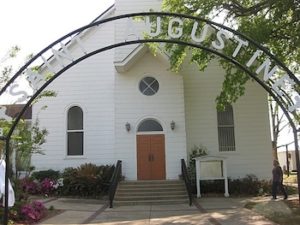
St. AugustineChurch (2005)
This date in 1842 marks the dedication of Saint Augustine's Catholic Church in New Orleans.
Located in the Treme neighborhood, Saint Augustine has an exciting beginning. Hearing that Black church members were buying pews, white people in the area started a campaign to buy more pews than the colored folks. Thus, The War of the Pews began and was ultimately won by the free people of color who bought three pews for every one purchased by the whites. In an unprecedented social, political, and religious move, the colored members bought all the pews of both side aisles.
They gave those pews to the slaves as their exclusive place of worship, a first in the history of slavery in the United States. This mix of the pews resulted in the most integrated congregation in the country: one large row of free people of color, one large row of whites with a smattering of ethnicities, and two outer aisles of slaves.
The property on which Saint Augustine stands was part of a plantation estate, tilery, and brickyard headquarters built in 1720. It was part of the province of New Orleans’ supervisor, the Company of the Indies, an economic stimulus for the province. In 1731, the Company of the Indies left, and the plantation was sold to the Moreau family, eventually coming into the possession of Julie Moreau, a manumitted slave, in 1775. Soon after, Claude Treme, a Frenchman, married Moreau and took title to the property. The couple subdivided the estate and sold off many lots on a first-come-first-served basis to free people of color and others from the Old Quarter, including Haitian immigrants fleeing the 1791 revolution in Haiti. After selling 35 lots, the Tremes left their plantation home in 1810.
In 1834, Jeanne Marie Aliquot purchased the Treme’s former home and property from New Orleans and brought in the United States’ first Catholic elementary school for free girls of color and a few slaves. This school had been started in 1823 by Martha Fortier, a one-time postulant of the Hospital Nuns. Jeanne Marie Aliquot became a major catalyst in the origins of Saint Augustine Church.
Under economic pressure, Jeanne Marie sold the house to the Ursuline Sisters in 1836. They sold the property to the Carmelites in 1840, then took over the school for colored girls and merged it with their school for white girls. The Carmelite Sisters used the Treme home for their motherhouse until 1926, when they moved out to Robert E. Lee Boulevard in the West End section of New Orleans.
Jeanne Marie Aliquot, the prime catalyst for the development of the St. Augustine campus, is rescued from the Mississippi River by a colored fisherman as she slips overboard while attempting to disembark a ship from France.
On January 3, Jeanne Marie Aliquot purchased the Claude Treme property for $9,000. Soon after, at her invitation, Marthe Fortiere moved the elementary school she found into the Claude Treme house.
In the late 1830s, when free people of color got permission from Bishop Antoine Blanc to build a church, the Ursulines donated the corner property at Bayou Road (now Governor Nicholls St.) and St. Claude, which they had bought for $10,000, on the condition that the church is named after their founders, St. Angela Merici.
On November 14, 1842, free people of color lay the capstone of Saint Augustine Church on the corner of St. Claude Avenue and Bayou Road (Governor Nicholls St.) on the Claude Treme property.
The Civil Rights Bill passed on June 19, 1964, banning discrimination in voting, jobs, and all public accommodations, caused whites to leave Treme in considerable numbers, causing Saint Augustine Church to morph into a predominantly Black congregation.
On October 30, 1964, amid a Gospel Extravaganza unfolding in the Saint. Augustine parking lot, Archbishop Alfred Schulte, standing near the church garden area and accompanied by a large crowd from around the city and parts of the nation, blessed and dedicated The Tomb of the Unknown Slave, a shrine consisting of outsize marine chains welded together with shackles and iron balls to form a huge, fallen cross. An explanatory plaque hangs on the church wall next to the shrine.
Hurricane Katrina hit the Gulf Coast on August 23, and New Orleans levees are breached in its aftermath, flooding the city. St. Augustine Church survived the storm with minimal damage, and as citizens returned, the parish focused on victim relief and the city's rebuilding.
Since its dedication, St. Augustine has been a church of the free Black citizens of New Orleans, welcoming both free and slaves as worshipers. Except for a brief six-month period when its sanctuary was enlarged and blessed in time for Christmas 1925, Saint Augustine Church has been in continuous use as a place of worship until the present time. Other information can be found at the Saint Augustine Catholic Church of New Orleans, the oldest Catholic Church in America.